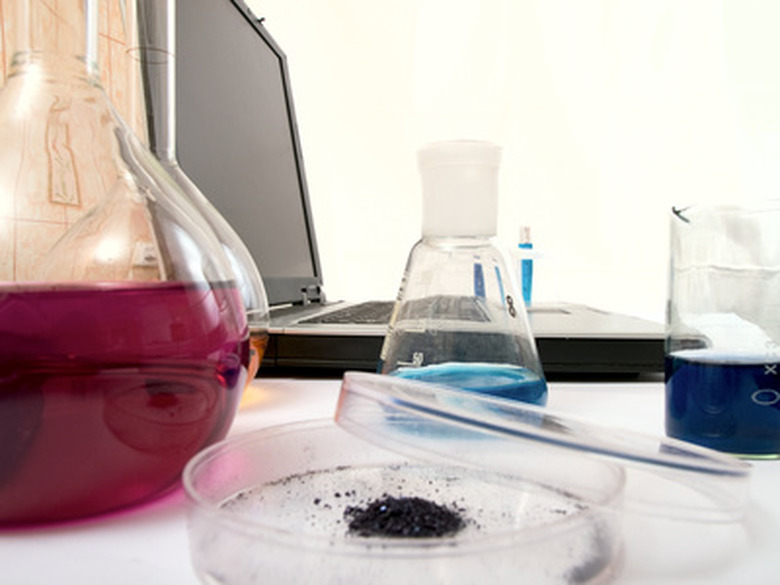How To Determine Volume Bases & Volume Acids In Titration
Acid-base titration is a straightforward way to measure concentrations. Chemists add a titrant, an acid or base of known concentration and then monitor change in pH. Once the pH reaches the equivalence point, all of the acid or base in the original solution has been neutralized. By measuring the volume of titrant added, the chemist can determine the concentration of the original solution. This procedure applies for acids and bases that only donate/accept one hydrogen ion. Other compounds like sulfuric acid have multiple equivalence points, so their titration curves are more complicated.
Step 1
Estimate the pH at the equivalence point. For a strong acid or base in solution, the pH at equivalence will be 0. When a strong acid reacts with a weak base, however, they form an acidic salt, so the pH at equivalence will be less than 7, while the pH of a strong base reacting with a weak acid will be greater than 7 for the same reason.
A good way to determine what you expect will happen is to write out the chemical equation for the neutralization reaction and identify the products. Once all of the acid or base has been neutralized, the products will be all that's left, so they will determine pH.
Step 2
Select a pH indicator based on the pH you expect at equivalence. Choose a pH indicator that changes color at or near the pH you expect at the equivalence point.
Step 3
Put on the chemical splash goggles, lab coat and gloves. Conduct the remainder of this experiment under the fume hood for safety.
Step 4
Fill the burette with the titrant. Choose the most appropriate titrant. Dilute the titrant and record its concentration. Remember when diluting the titrant that acid should always be added to water, not the other way around. Strong acids or bases are generally used as titrants; it's more difficult to find the equivalence point using a weak acid or base as the titrant. Titrate an acidic solution with a strong base like sodium hydroxide. Titrate a basic solution with a strong acid like hydrochloric/muriatic acid.
Step 5
Place the flask or beaker under the burette. Record the volume of the solution contained in the flask.
Step 6
Add titrant to the beaker/flask slowly. The pH change at the equivalence point is dramatic and happens quickly. As soon as the pH indicator changes color, cease adding titrant and record the volume of titrant you added. The burette will typically have volume markings along the side, so you can determine how much you've used.
Step 7
Calculate the number of moles of titrant added by multiplying the volume of titrant you used by the concentration of the acid or base in the titrant. The number of moles added to reach the equivalence point is equal to the number of moles of acid or base originally present in the solution.
Step 8
Divide the number of moles of acid or base by the number of liters in the flask or beaker before the titration to get the moles per liter or concentration of the original solution.
Things Needed
- Burette
- pH indicator
- Borosilicate, or Pyrex, flask or beaker
- Chemical splash goggles
- Gloves
- Lab coat
- Fume hood
- Dilute muriatic acid or sodium hydroxide of known concentration
Warning
Strong acids and bases are dangerous chemicals. Never try to perform this experiment without proper safety equipment, including chemical splash goggles, gloves and a fume hood. Always exercise care and caution when transporting, using or diluting strong acids and bases. Always add acid to water and not the other way around. Do not ingest these chemicals or allow them to come in contact with your face, hands, eyes or skin. If accidental exposure occurs, seek medical attention immediately.
References
- "Chemical Principles, the Quest for Insight, 4th Edition"; Peter Atkins and Loretta Jones; 2008.
Cite This Article
MLA
Brennan, John. "How To Determine Volume Bases & Volume Acids In Titration" sciencing.com, https://www.sciencing.com/determine-bases-volume-acids-titration-6959790/. 24 April 2017.
APA
Brennan, John. (2017, April 24). How To Determine Volume Bases & Volume Acids In Titration. sciencing.com. Retrieved from https://www.sciencing.com/determine-bases-volume-acids-titration-6959790/
Chicago
Brennan, John. How To Determine Volume Bases & Volume Acids In Titration last modified March 24, 2022. https://www.sciencing.com/determine-bases-volume-acids-titration-6959790/
